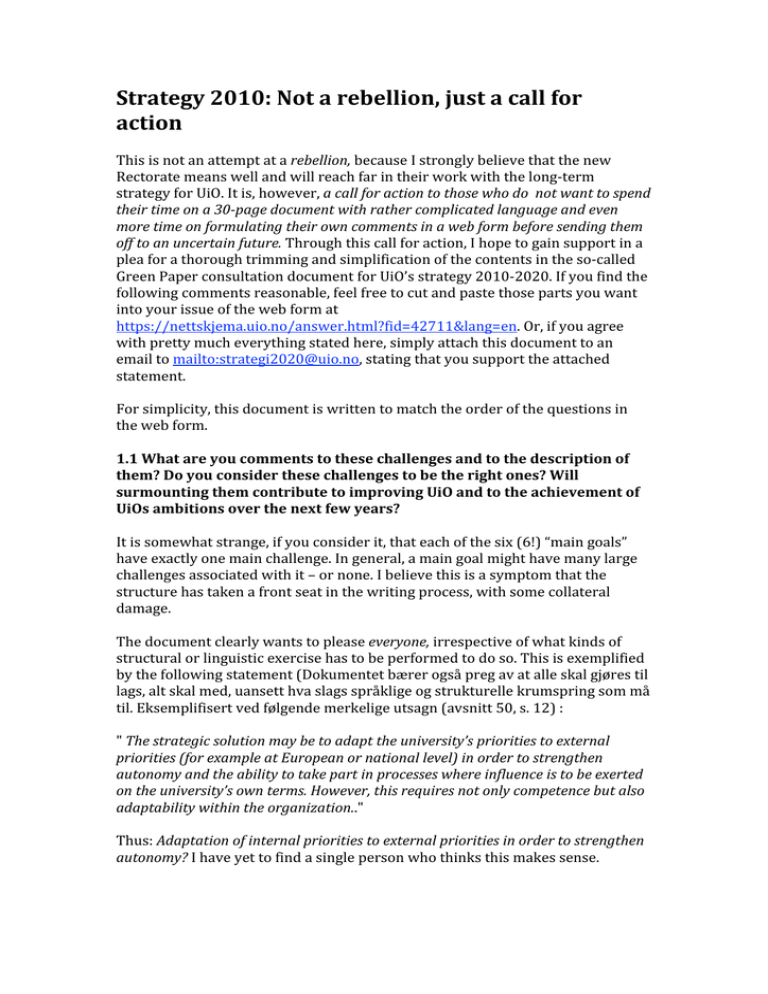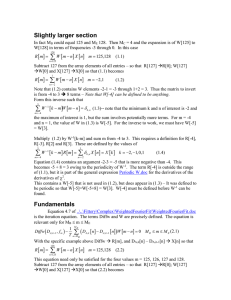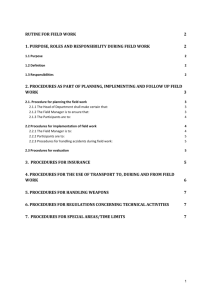Strategy 2010: Not a rebellion, just a call for action
advertisement

Strategy 2010: Not a rebellion, just a call for action This is not an attempt at a rebellion, because I strongly believe that the new Rectorate means well and will reach far in their work with the long‐term strategy for UiO. It is, however, a call for action to those who do not want to spend their time on a 30­page document with rather complicated language and even more time on formulating their own comments in a web form before sending them off to an uncertain future. Through this call for action, I hope to gain support in a plea for a thorough trimming and simplification of the contents in the so‐called Green Paper consultation document for UiO’s strategy 2010‐2020. If you find the following comments reasonable, feel free to cut and paste those parts you want into your issue of the web form at https://nettskjema.uio.no/answer.html?fid=42711&lang=en. Or, if you agree with pretty much everything stated here, simply attach this document to an email to mailto:strategi2020@uio.no, stating that you support the attached statement. For simplicity, this document is written to match the order of the questions in the web form. 1.1 What are you comments to these challenges and to the description of them? Do you consider these challenges to be the right ones? Will surmounting them contribute to improving UiO and to the achievement of UiOs ambitions over the next few years? It is somewhat strange, if you consider it, that each of the six (6!) “main goals” have exactly one main challenge. In general, a main goal might have many large challenges associated with it – or none. I believe this is a symptom that the structure has taken a front seat in the writing process, with some collateral damage. The document clearly wants to please everyone, irrespective of what kinds of structural or linguistic exercise has to be performed to do so. This is exemplified by the following statement (Dokumentet bærer også preg av at alle skal gjøres til lags, alt skal med, uansett hva slags språklige og strukturelle krumspring som må til. Eksemplifisert ved følgende merkelige utsagn (avsnitt 50, s. 12) : " The strategic solution may be to adapt the university’s priorities to external priorities (for example at European or national level) in order to strengthen autonomy and the ability to take part in processes where influence is to be exerted on the university’s own terms. However, this requires not only competence but also adaptability within the organization.." Thus: Adaptation of internal priorities to external priorities in order to strengthen autonomy? I have yet to find a single person who thinks this makes sense. Are these challenges the right ones? No, not as “main challenges”. To make a list of main challenges in a strategic plan effective, it has to be short enough and unifying enough that everyone can live by it, every day, and contribute to solutions that brings us closer to achieving the overarching objective. One should rather use terms like “techniques” or “means” instead of “main challenges”, and “strategies” instead of “main goals”. There’s a vague distinction between the two in this context, however, so feel free to mix and match to vary your language! For example: Quality‐consciousness is a means or a strategy to reach an overarching objective, likewise for action‐orientation, and being groundbreaking, or strenghtening focus on quality, establishing a unified programme for the contribution of human and material resources to the production of knowledge, etc Don’t get me wrong: None of the “main challenges” are “wrong” per se, they all represent good ideas and intentions – but as a summary of challenges ahead they fail miserably! If surmounted, the so‐called “main challenges” will definitely contribute to attaining the overarching objective, by and large (albeit, I fear, with some collateral damage). And there are tons of great strategies, techniques, principles, ideas, and means mentioned in this document – bravo! 1.2 The following challenge(s) are lacking:: I consider the real challenges to be: 1. Creating the best possible environment and support services for the execution of research, education, and outreach at a high level of excellence by international standards. 2. Creating good indicators and reward systems that measure exactly what we want to prioritize (research, education, and outreach), without too much red tape involved for those who do these activities. 3. Creating an environment and a support apparatus that actively encourages activities that increase the financing available for the primary acivities (research, education, and outreach), from both external and internal sources (government budget allocations). 1.3 Explanation [Rationale]: 1. Those who perform these tasks are the University’s “primary producers”, and creating a good environment and support services for them and their activities will increase the production and benefit recruitment. 2. Without good indicators measuring exactly what we want to prioritize, we are blind. Without reward systems, the incentives to improve “output” are smaller than they would otherwise be – though given a good and generally accepted set of indicators, most academics are reasonably self‐motivated, unless they’re in a terrible squeeze with regard to basic resources. 3. As noted by the Green Paper, external financing will become more and more important in the future, and that means we should have a smoothly functioning support apparatus for those who apply for, and receive, external funds. There are also, however, things that can be done to influence the allocation of the overall budget for research and education, in particular refereed papers and ECTS credit production. We should even aim to influence the size of the total budget through outreach activities! 2.1. Do you have suggestions for [measures that will help to steer UiO in the desired direction]? Note that these must be measures which UiO itself can carry out. External factors, such as allocations etc are not relevant here. 1. Many current and future projects have/will have income in Euros and expenses in NOK. In industry, tools for managing such inconveniences by locking in the exchange rate at a given time are a natural part of the budgeting and planning process – it should become a standard tool that is easily accessible to each project manager at the University. 2. Some projectes (e.g. those financed by the European Space Agency) are exempt from VAT (MVA) – but according to EU rules, the tax must first be paid and then reclaimed from the Norwegian authorities. At the Institute of Theoretical Astrophysics, we have tried since last August to find out how this is supposed to be done most easily with respect to the accounting department, but per medio January, we have still not reached the point of sending in an application to reclaim the taxes paid by one such project. Such services and/or advice should be readily available to the project managers, and there ought to be a culture of administrative excellence that takes pride in solving such red tape problems in a speedy fashion. 3. Many large projects require the hiring of temporary technical‐ administrative staff to execute the tasks involved. But many of the best‐qualified people for these jobs do not wish uncertain, temporary employment, and therefore take up permanent positions elsewhere, most likely with better pay. There ought to be a central fund to take on the economic risk that would otherwise fall on the institutes if these were to be hired, instead, on a permanent basis. If funding stops completely, the employees can be switched onto other projects in other places, with the added bonus of transferring knowledge between different units. For the sake of disclosure: I am a temporary employee in the technical‐administrative category myself. 4. As many of the permanent employees at UiO are about to be retired, a generation with a few exceptional talents is waiting outside in the cold. They won’t wait too long, given today’s labour market. There ought to be a “time smoothing fund” that gives the institutes an opportunity to hire a few exceptional recruites before they “disappear” to other countries or other jobs. Again, for the sake of disclosure: I count myself among those who gave up on an academic career for this and other reasons. 5. Create permanent suggestion boxes (both real and virtual ones) where people can make suggestions as to how the University can attain its goals, give feedback on suggestions and reward (at least with honourable mention) those suggestions that are implemented. This is standard practice at e.g. NASA’s Goddard Space Flight Center: Anyone, from the top scientist to the cleaning staff, are encouraged to submit suggestions – anonymously if so desired. Some months ago, I ended up sending an email with three of these suggestions to what I thought was an appropriate recipient at the administration. I have not heard back – at all. I think a number of people do go around with great ideas that would solve many problems, but they feel that suggestions are not welcome, anywhere. 2.2. Can you suggest any good indicators for the overarching goals and main goals outlined in the Green Paper (Ch.s 5­6)? How do we know that UiO might do better? How do we measure or evaluate whether we are moving in the right direction? These need not necessarily be quantitative goals, but we must be able to measure progress and reveal lack of progress. As indicated above, this is one of the real challenges. Count all desireable activities – not just some. In particular, outreach activities have been sadly neglected in this regard – no wonder people think UiO is participating too little in the public discourse! How about a self‐reporting syste for all outreach activities? How about an explicit policy stating that outreach activities in scools, kindergartens, all kinds of groups and associations is desireable, and should be counted as part of your working time regardless of whether it’s done outside of working hours? Including time spent to prepare, of course. Reward all desireable activities – not just some. Based on measurable indicators, of course (but they might well be of a self‐reporting nature). Note: ECTS credit production and publication in peer‐reviewed journals is already rewarded with money in the bank at the institute level. In general, one has to be careful not to reach a consensus on buzzwords that are later on applied (with force) to all areas of activity. They get written into almost all applications and reports, but they do not mean much at all. Does science benefit from “mobility” itself? Of course not. These words make sense only in a political setting. “Everyone” knows that the substance of the grant applications and the research done would be largely unaffected if the buzzwords were changed overnight. Let us not set this trap for ourselves – we do not have to do that. If some group carries out excellent, high‐international‐standard research and education with a good outreach program, should they be penalized if they are not part of a formalized network? Are they to be forced into spending more time on what passes as “main goals” in the current Green Paper? Of course not! Therefore it is imperative that your goals (and your indicators) spell out exactly what you really want to achieve. The goals and the indicators should not refer to the methods dictated by current fashion, because the methods are not the goals! And as a comment to the web form itself: “lack of progress” – measured with even the best of indicators – is not a negative thing if you’re already at the top! 3.1 [Further comments] Section 5 seems oddly detached from the rest of the paper, and here too there are too many, vague, and overlapping principles to work well as a summary. What is the difference between a “strategic approach – from the individual employee to the entire university” and “more scope for opportunities – all resources viewed in an overall perspective”? Greater independence – are we really so terribly dependent right now? And is the solution to dependence to adapt our priorities to the external priorities? Better leadership – what does that really mean? The overarching objective of the Green Paper ("the University of Oslo shall strengthen its position as an outstanding European research‐intensive university and place of learning, with an action‐oriented social commitment") is not too bad, and summarises that we have grand ambitions in all three areas that we have been charged with by Norwegian law: research, education, and outreach. The statement could easily be trimmed down, however: Given the legal and social context, the statement “the University of Oslo shall strengthen its position as an outstanding university” means pretty much the same. Though it might be considered… too short? I still vote for a shortened version, with 3 main challenges to go with it. Then, a long list of strategies, principles, ideas, techniques and means that can be shown – in a traceable manner – as contributing to overcome the challenges, bringing the university closer to attaining the overarching objective. With fewer superfluous words, repetitions and overlaps originating from the adaptation of otherwise good ideas to an awkward and complicated document structure. Dr. Scient. Stein Vidar Hagfors Haugan Senior Engineer, Institutt for teoretisk astrofysikk



